Analyzing IoT for Smart Logistics and Manufacturing in Enterprises
VerifiedAdded on 2023/06/05
|13
|2316
|438
Report
AI Summary
This report examines the impact of the Internet of Things (IoT) on smart enterprises, with a focus on smart logistics and smart manufacturing. It begins by introducing IoT and its impacts on businesses, highlighting its role in inventory management and logistics effectiveness. The report then delves into smart logistics, presenting case studies of Deloitte and 20Cube Logistics Pte Ltd., detailing their technology use, implementation aspects, and competitive advantages gained through IoT. Following this, the report explores smart manufacturing, with case studies of Fujitsu and Clavax, showcasing how these companies leverage IoT for factory optimization, production innovation, and improved operational efficiency. The report concludes by emphasizing the transformative potential of IoT in making service delivery faster and more efficient, while also acknowledging the security challenges associated with its implementation.
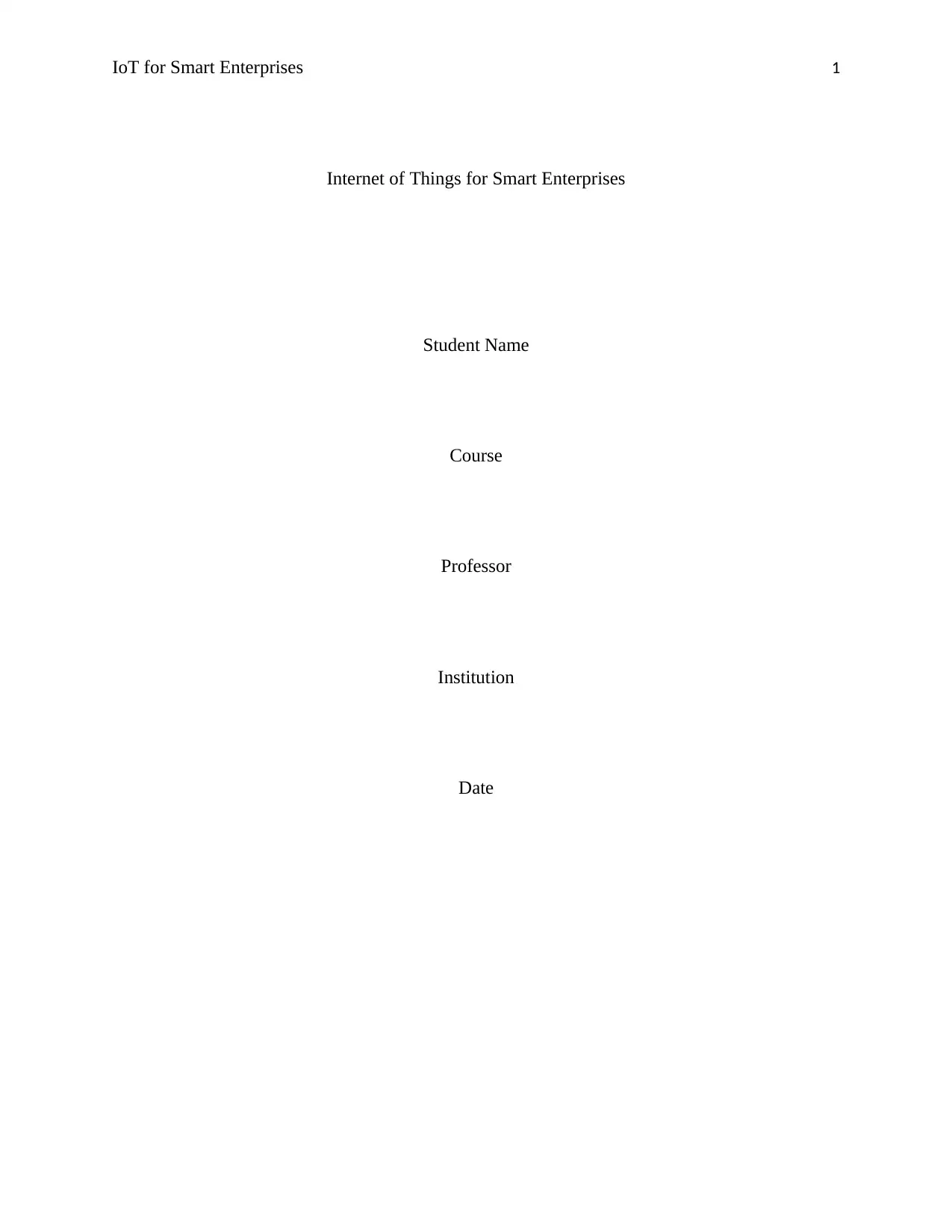
IoT for Smart Enterprises 1
Internet of Things for Smart Enterprises
Student Name
Course
Professor
Institution
Date
Internet of Things for Smart Enterprises
Student Name
Course
Professor
Institution
Date
Paraphrase This Document
Need a fresh take? Get an instant paraphrase of this document with our AI Paraphraser
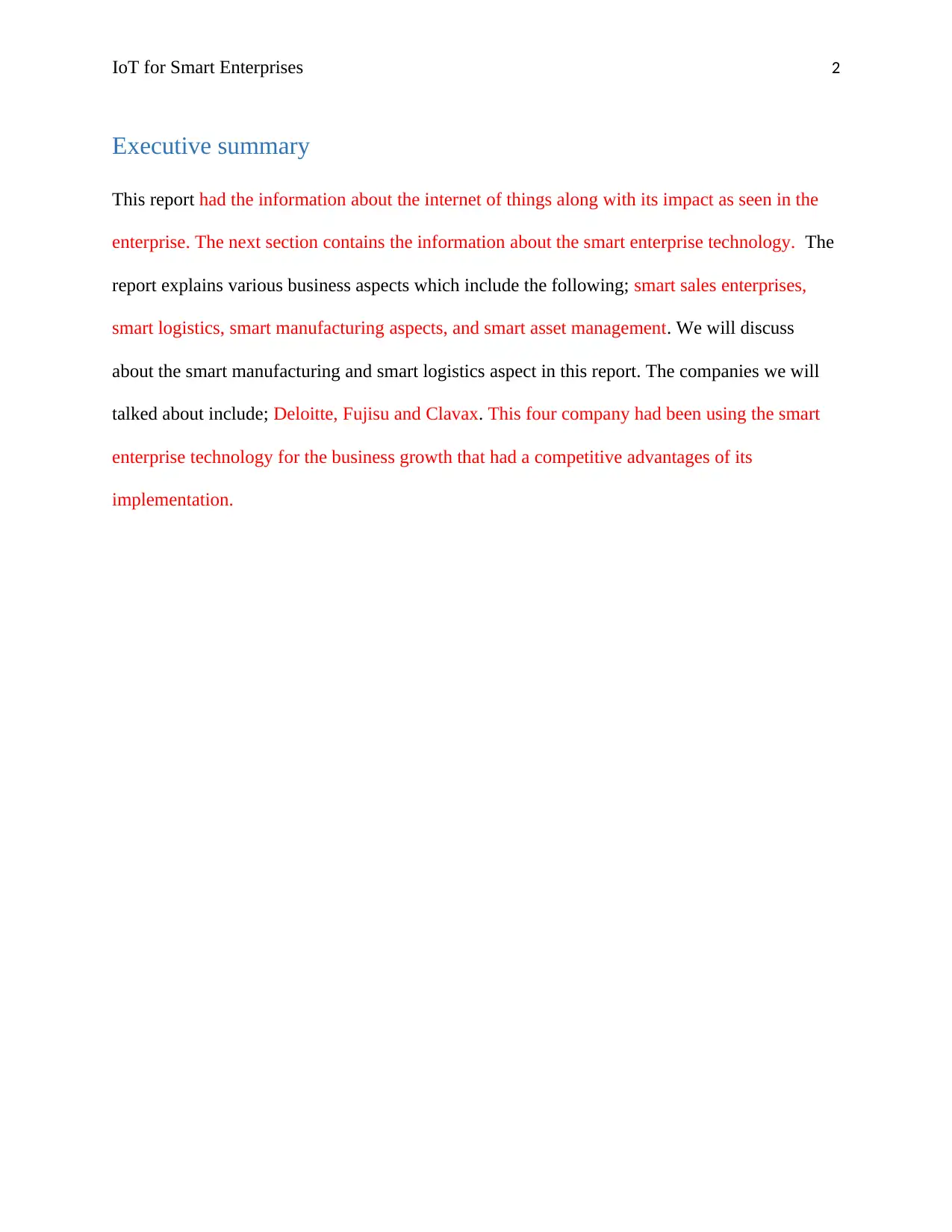
IoT for Smart Enterprises 2
Executive summary
This report had the information about the internet of things along with its impact as seen in the
enterprise. The next section contains the information about the smart enterprise technology. The
report explains various business aspects which include the following; smart sales enterprises,
smart logistics, smart manufacturing aspects, and smart asset management. We will discuss
about the smart manufacturing and smart logistics aspect in this report. The companies we will
talked about include; Deloitte, Fujisu and Clavax. This four company had been using the smart
enterprise technology for the business growth that had a competitive advantages of its
implementation.
Executive summary
This report had the information about the internet of things along with its impact as seen in the
enterprise. The next section contains the information about the smart enterprise technology. The
report explains various business aspects which include the following; smart sales enterprises,
smart logistics, smart manufacturing aspects, and smart asset management. We will discuss
about the smart manufacturing and smart logistics aspect in this report. The companies we will
talked about include; Deloitte, Fujisu and Clavax. This four company had been using the smart
enterprise technology for the business growth that had a competitive advantages of its
implementation.
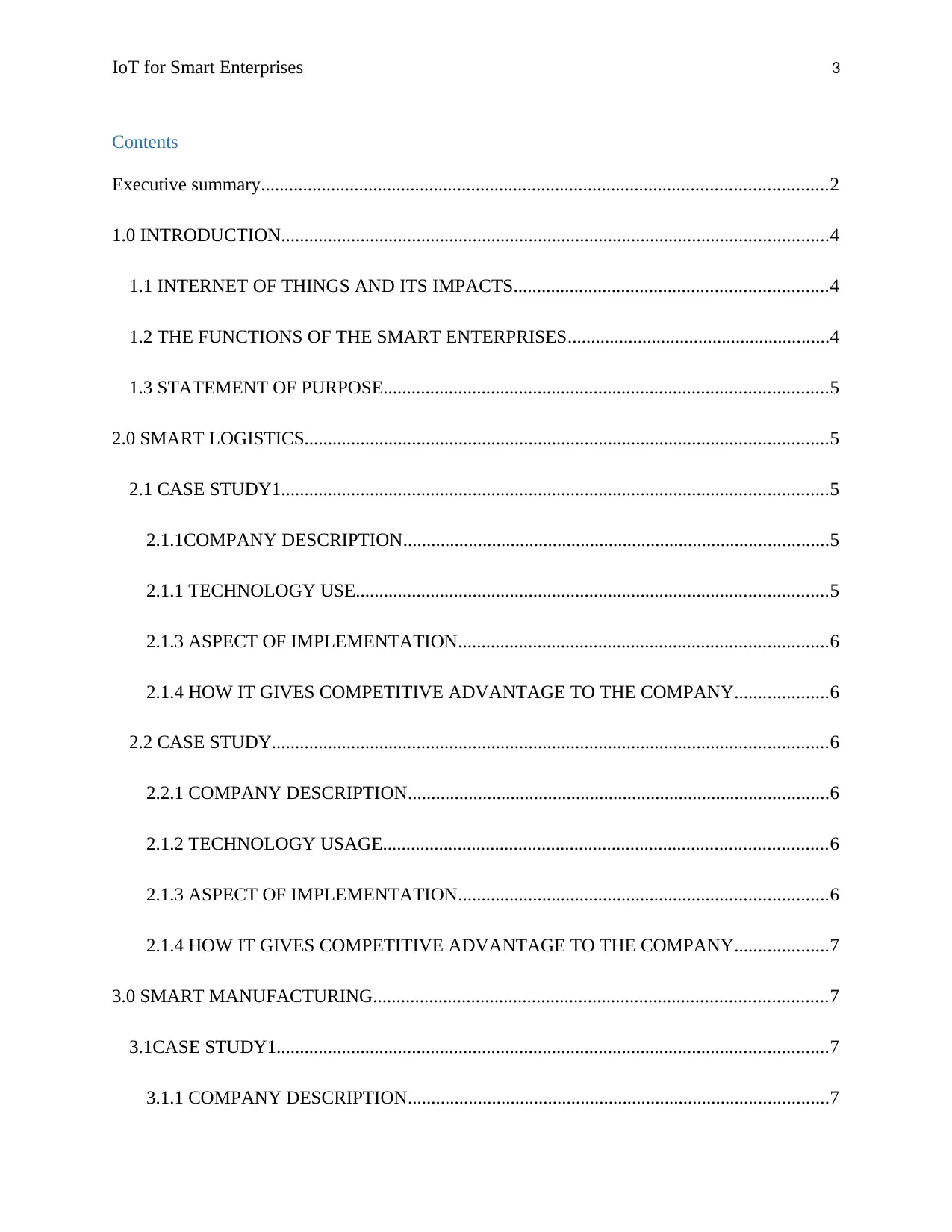
IoT for Smart Enterprises 3
Contents
Executive summary.........................................................................................................................2
1.0 INTRODUCTION.....................................................................................................................4
1.1 INTERNET OF THINGS AND ITS IMPACTS...................................................................4
1.2 THE FUNCTIONS OF THE SMART ENTERPRISES........................................................4
1.3 STATEMENT OF PURPOSE...............................................................................................5
2.0 SMART LOGISTICS................................................................................................................5
2.1 CASE STUDY1.....................................................................................................................5
2.1.1COMPANY DESCRIPTION...........................................................................................5
2.1.1 TECHNOLOGY USE.....................................................................................................5
2.1.3 ASPECT OF IMPLEMENTATION...............................................................................6
2.1.4 HOW IT GIVES COMPETITIVE ADVANTAGE TO THE COMPANY....................6
2.2 CASE STUDY.......................................................................................................................6
2.2.1 COMPANY DESCRIPTION..........................................................................................6
2.1.2 TECHNOLOGY USAGE...............................................................................................6
2.1.3 ASPECT OF IMPLEMENTATION...............................................................................6
2.1.4 HOW IT GIVES COMPETITIVE ADVANTAGE TO THE COMPANY....................7
3.0 SMART MANUFACTURING.................................................................................................7
3.1CASE STUDY1......................................................................................................................7
3.1.1 COMPANY DESCRIPTION..........................................................................................7
Contents
Executive summary.........................................................................................................................2
1.0 INTRODUCTION.....................................................................................................................4
1.1 INTERNET OF THINGS AND ITS IMPACTS...................................................................4
1.2 THE FUNCTIONS OF THE SMART ENTERPRISES........................................................4
1.3 STATEMENT OF PURPOSE...............................................................................................5
2.0 SMART LOGISTICS................................................................................................................5
2.1 CASE STUDY1.....................................................................................................................5
2.1.1COMPANY DESCRIPTION...........................................................................................5
2.1.1 TECHNOLOGY USE.....................................................................................................5
2.1.3 ASPECT OF IMPLEMENTATION...............................................................................6
2.1.4 HOW IT GIVES COMPETITIVE ADVANTAGE TO THE COMPANY....................6
2.2 CASE STUDY.......................................................................................................................6
2.2.1 COMPANY DESCRIPTION..........................................................................................6
2.1.2 TECHNOLOGY USAGE...............................................................................................6
2.1.3 ASPECT OF IMPLEMENTATION...............................................................................6
2.1.4 HOW IT GIVES COMPETITIVE ADVANTAGE TO THE COMPANY....................7
3.0 SMART MANUFACTURING.................................................................................................7
3.1CASE STUDY1......................................................................................................................7
3.1.1 COMPANY DESCRIPTION..........................................................................................7
⊘ This is a preview!⊘
Do you want full access?
Subscribe today to unlock all pages.

Trusted by 1+ million students worldwide
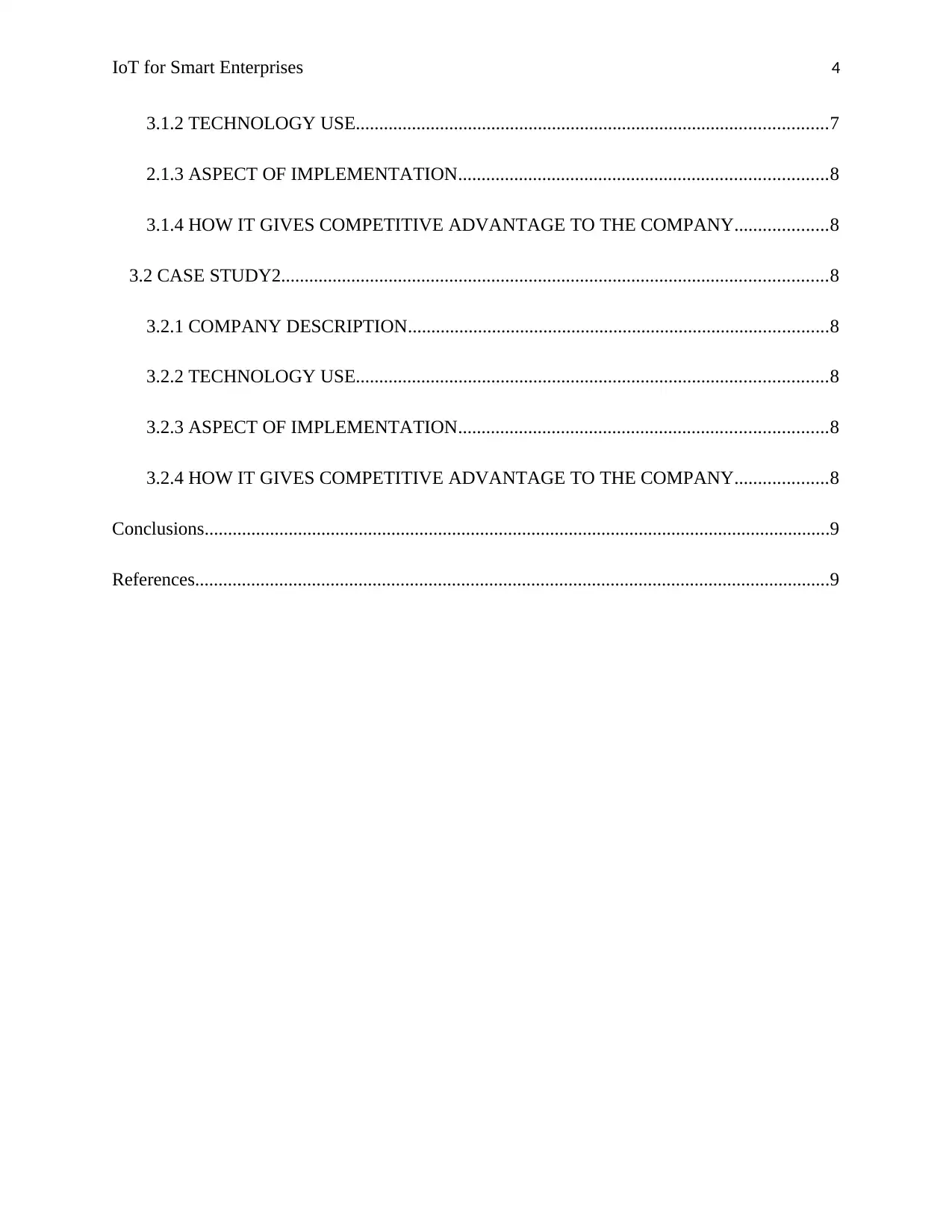
IoT for Smart Enterprises 4
3.1.2 TECHNOLOGY USE.....................................................................................................7
2.1.3 ASPECT OF IMPLEMENTATION...............................................................................8
3.1.4 HOW IT GIVES COMPETITIVE ADVANTAGE TO THE COMPANY....................8
3.2 CASE STUDY2.....................................................................................................................8
3.2.1 COMPANY DESCRIPTION..........................................................................................8
3.2.2 TECHNOLOGY USE.....................................................................................................8
3.2.3 ASPECT OF IMPLEMENTATION...............................................................................8
3.2.4 HOW IT GIVES COMPETITIVE ADVANTAGE TO THE COMPANY....................8
Conclusions......................................................................................................................................9
References........................................................................................................................................9
3.1.2 TECHNOLOGY USE.....................................................................................................7
2.1.3 ASPECT OF IMPLEMENTATION...............................................................................8
3.1.4 HOW IT GIVES COMPETITIVE ADVANTAGE TO THE COMPANY....................8
3.2 CASE STUDY2.....................................................................................................................8
3.2.1 COMPANY DESCRIPTION..........................................................................................8
3.2.2 TECHNOLOGY USE.....................................................................................................8
3.2.3 ASPECT OF IMPLEMENTATION...............................................................................8
3.2.4 HOW IT GIVES COMPETITIVE ADVANTAGE TO THE COMPANY....................8
Conclusions......................................................................................................................................9
References........................................................................................................................................9
Paraphrase This Document
Need a fresh take? Get an instant paraphrase of this document with our AI Paraphraser
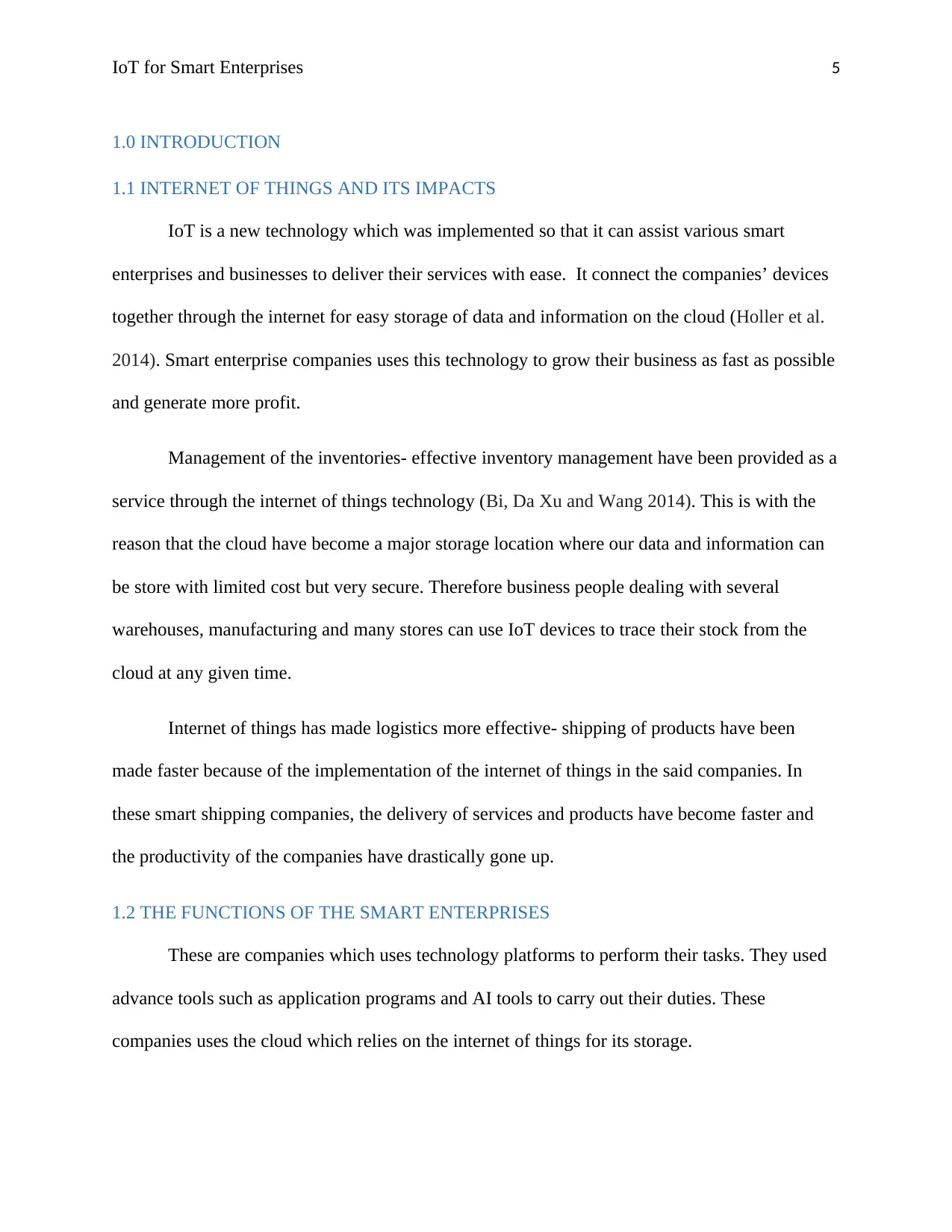
IoT for Smart Enterprises 5
1.0 INTRODUCTION
1.1 INTERNET OF THINGS AND ITS IMPACTS
IoT is a new technology which was implemented so that it can assist various smart
enterprises and businesses to deliver their services with ease. It connect the companies’ devices
together through the internet for easy storage of data and information on the cloud (Holler et al.
2014). Smart enterprise companies uses this technology to grow their business as fast as possible
and generate more profit.
Management of the inventories- effective inventory management have been provided as a
service through the internet of things technology (Bi, Da Xu and Wang 2014). This is with the
reason that the cloud have become a major storage location where our data and information can
be store with limited cost but very secure. Therefore business people dealing with several
warehouses, manufacturing and many stores can use IoT devices to trace their stock from the
cloud at any given time.
Internet of things has made logistics more effective- shipping of products have been
made faster because of the implementation of the internet of things in the said companies. In
these smart shipping companies, the delivery of services and products have become faster and
the productivity of the companies have drastically gone up.
1.2 THE FUNCTIONS OF THE SMART ENTERPRISES
These are companies which uses technology platforms to perform their tasks. They used
advance tools such as application programs and AI tools to carry out their duties. These
companies uses the cloud which relies on the internet of things for its storage.
1.0 INTRODUCTION
1.1 INTERNET OF THINGS AND ITS IMPACTS
IoT is a new technology which was implemented so that it can assist various smart
enterprises and businesses to deliver their services with ease. It connect the companies’ devices
together through the internet for easy storage of data and information on the cloud (Holler et al.
2014). Smart enterprise companies uses this technology to grow their business as fast as possible
and generate more profit.
Management of the inventories- effective inventory management have been provided as a
service through the internet of things technology (Bi, Da Xu and Wang 2014). This is with the
reason that the cloud have become a major storage location where our data and information can
be store with limited cost but very secure. Therefore business people dealing with several
warehouses, manufacturing and many stores can use IoT devices to trace their stock from the
cloud at any given time.
Internet of things has made logistics more effective- shipping of products have been
made faster because of the implementation of the internet of things in the said companies. In
these smart shipping companies, the delivery of services and products have become faster and
the productivity of the companies have drastically gone up.
1.2 THE FUNCTIONS OF THE SMART ENTERPRISES
These are companies which uses technology platforms to perform their tasks. They used
advance tools such as application programs and AI tools to carry out their duties. These
companies uses the cloud which relies on the internet of things for its storage.
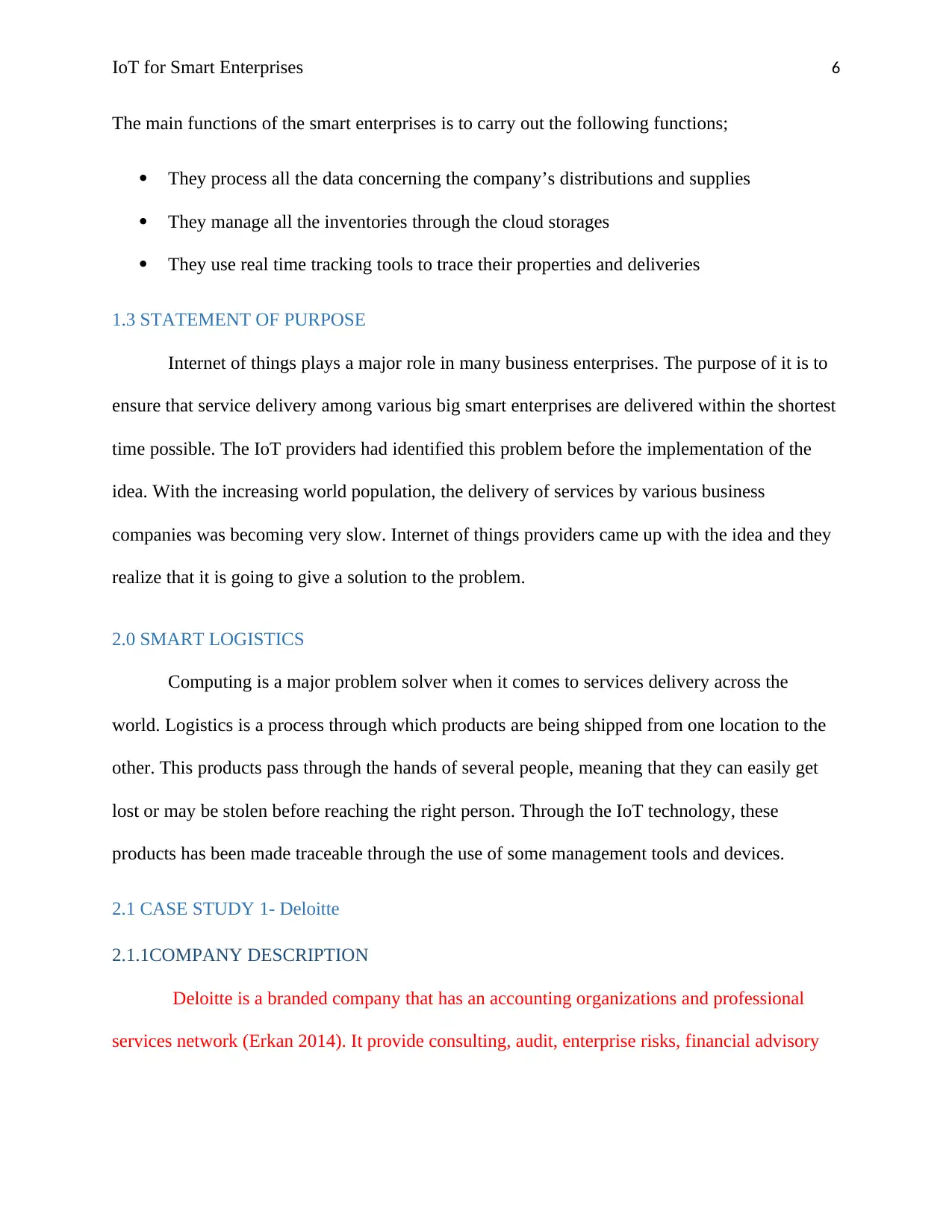
IoT for Smart Enterprises 6
The main functions of the smart enterprises is to carry out the following functions;
They process all the data concerning the company’s distributions and supplies
They manage all the inventories through the cloud storages
They use real time tracking tools to trace their properties and deliveries
1.3 STATEMENT OF PURPOSE
Internet of things plays a major role in many business enterprises. The purpose of it is to
ensure that service delivery among various big smart enterprises are delivered within the shortest
time possible. The IoT providers had identified this problem before the implementation of the
idea. With the increasing world population, the delivery of services by various business
companies was becoming very slow. Internet of things providers came up with the idea and they
realize that it is going to give a solution to the problem.
2.0 SMART LOGISTICS
Computing is a major problem solver when it comes to services delivery across the
world. Logistics is a process through which products are being shipped from one location to the
other. This products pass through the hands of several people, meaning that they can easily get
lost or may be stolen before reaching the right person. Through the IoT technology, these
products has been made traceable through the use of some management tools and devices.
2.1 CASE STUDY 1- Deloitte
2.1.1COMPANY DESCRIPTION
Deloitte is a branded company that has an accounting organizations and professional
services network (Erkan 2014). It provide consulting, audit, enterprise risks, financial advisory
The main functions of the smart enterprises is to carry out the following functions;
They process all the data concerning the company’s distributions and supplies
They manage all the inventories through the cloud storages
They use real time tracking tools to trace their properties and deliveries
1.3 STATEMENT OF PURPOSE
Internet of things plays a major role in many business enterprises. The purpose of it is to
ensure that service delivery among various big smart enterprises are delivered within the shortest
time possible. The IoT providers had identified this problem before the implementation of the
idea. With the increasing world population, the delivery of services by various business
companies was becoming very slow. Internet of things providers came up with the idea and they
realize that it is going to give a solution to the problem.
2.0 SMART LOGISTICS
Computing is a major problem solver when it comes to services delivery across the
world. Logistics is a process through which products are being shipped from one location to the
other. This products pass through the hands of several people, meaning that they can easily get
lost or may be stolen before reaching the right person. Through the IoT technology, these
products has been made traceable through the use of some management tools and devices.
2.1 CASE STUDY 1- Deloitte
2.1.1COMPANY DESCRIPTION
Deloitte is a branded company that has an accounting organizations and professional
services network (Erkan 2014). It provide consulting, audit, enterprise risks, financial advisory
⊘ This is a preview!⊘
Do you want full access?
Subscribe today to unlock all pages.

Trusted by 1+ million students worldwide
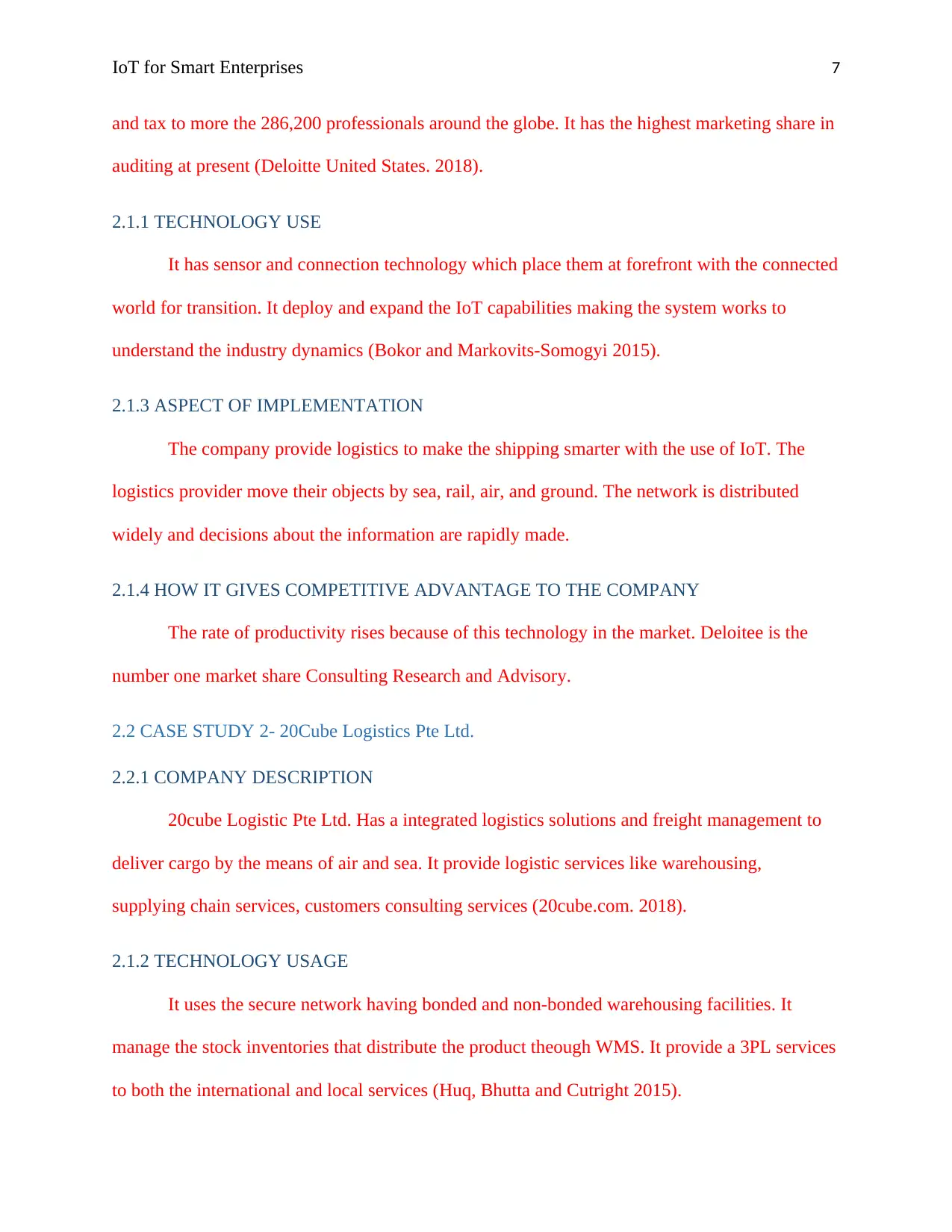
IoT for Smart Enterprises 7
and tax to more the 286,200 professionals around the globe. It has the highest marketing share in
auditing at present (Deloitte United States. 2018).
2.1.1 TECHNOLOGY USE
It has sensor and connection technology which place them at forefront with the connected
world for transition. It deploy and expand the IoT capabilities making the system works to
understand the industry dynamics (Bokor and Markovits-Somogyi 2015).
2.1.3 ASPECT OF IMPLEMENTATION
The company provide logistics to make the shipping smarter with the use of IoT. The
logistics provider move their objects by sea, rail, air, and ground. The network is distributed
widely and decisions about the information are rapidly made.
2.1.4 HOW IT GIVES COMPETITIVE ADVANTAGE TO THE COMPANY
The rate of productivity rises because of this technology in the market. Deloitee is the
number one market share Consulting Research and Advisory.
2.2 CASE STUDY 2- 20Cube Logistics Pte Ltd.
2.2.1 COMPANY DESCRIPTION
20cube Logistic Pte Ltd. Has a integrated logistics solutions and freight management to
deliver cargo by the means of air and sea. It provide logistic services like warehousing,
supplying chain services, customers consulting services (20cube.com. 2018).
2.1.2 TECHNOLOGY USAGE
It uses the secure network having bonded and non-bonded warehousing facilities. It
manage the stock inventories that distribute the product theough WMS. It provide a 3PL services
to both the international and local services (Huq, Bhutta and Cutright 2015).
and tax to more the 286,200 professionals around the globe. It has the highest marketing share in
auditing at present (Deloitte United States. 2018).
2.1.1 TECHNOLOGY USE
It has sensor and connection technology which place them at forefront with the connected
world for transition. It deploy and expand the IoT capabilities making the system works to
understand the industry dynamics (Bokor and Markovits-Somogyi 2015).
2.1.3 ASPECT OF IMPLEMENTATION
The company provide logistics to make the shipping smarter with the use of IoT. The
logistics provider move their objects by sea, rail, air, and ground. The network is distributed
widely and decisions about the information are rapidly made.
2.1.4 HOW IT GIVES COMPETITIVE ADVANTAGE TO THE COMPANY
The rate of productivity rises because of this technology in the market. Deloitee is the
number one market share Consulting Research and Advisory.
2.2 CASE STUDY 2- 20Cube Logistics Pte Ltd.
2.2.1 COMPANY DESCRIPTION
20cube Logistic Pte Ltd. Has a integrated logistics solutions and freight management to
deliver cargo by the means of air and sea. It provide logistic services like warehousing,
supplying chain services, customers consulting services (20cube.com. 2018).
2.1.2 TECHNOLOGY USAGE
It uses the secure network having bonded and non-bonded warehousing facilities. It
manage the stock inventories that distribute the product theough WMS. It provide a 3PL services
to both the international and local services (Huq, Bhutta and Cutright 2015).
Paraphrase This Document
Need a fresh take? Get an instant paraphrase of this document with our AI Paraphraser
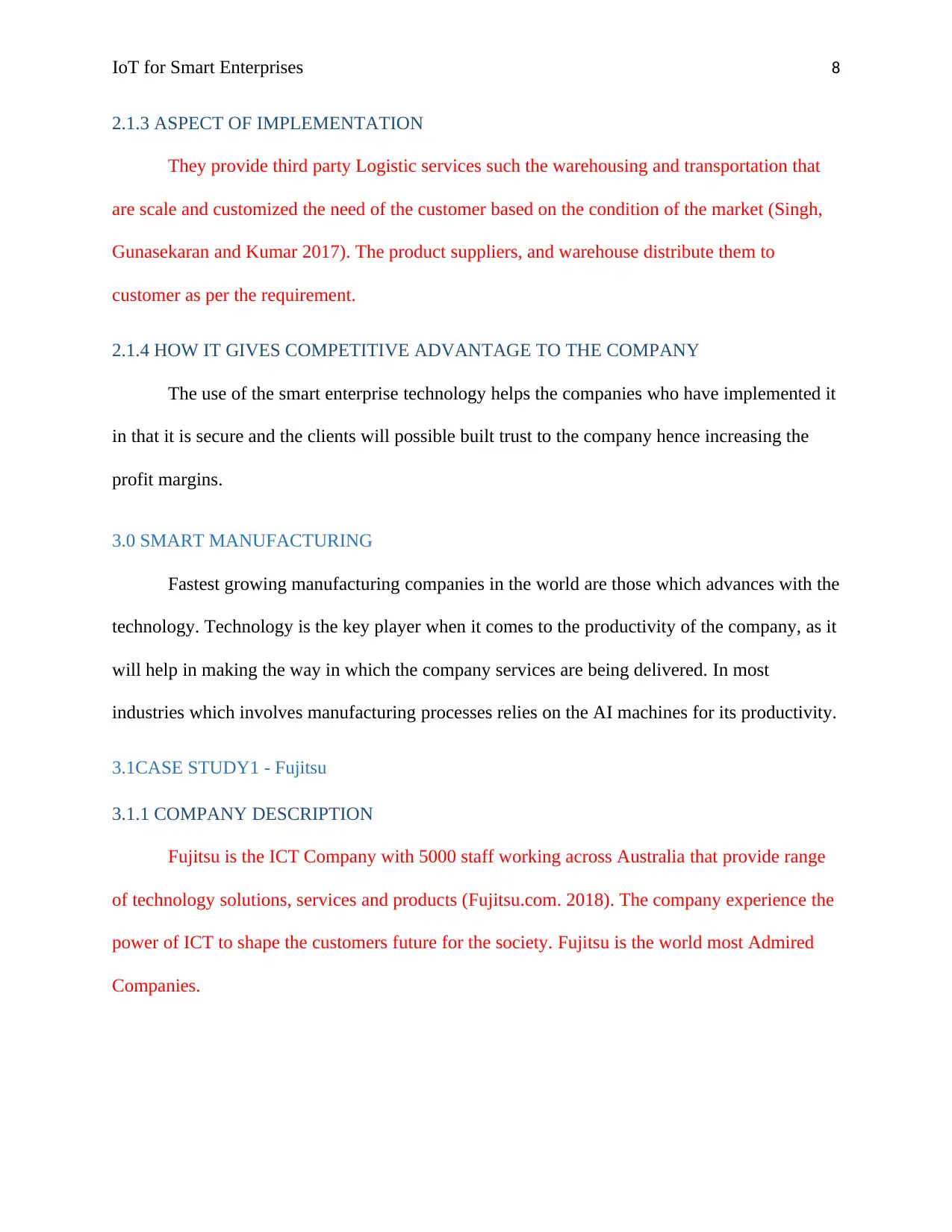
IoT for Smart Enterprises 8
2.1.3 ASPECT OF IMPLEMENTATION
They provide third party Logistic services such the warehousing and transportation that
are scale and customized the need of the customer based on the condition of the market (Singh,
Gunasekaran and Kumar 2017). The product suppliers, and warehouse distribute them to
customer as per the requirement.
2.1.4 HOW IT GIVES COMPETITIVE ADVANTAGE TO THE COMPANY
The use of the smart enterprise technology helps the companies who have implemented it
in that it is secure and the clients will possible built trust to the company hence increasing the
profit margins.
3.0 SMART MANUFACTURING
Fastest growing manufacturing companies in the world are those which advances with the
technology. Technology is the key player when it comes to the productivity of the company, as it
will help in making the way in which the company services are being delivered. In most
industries which involves manufacturing processes relies on the AI machines for its productivity.
3.1CASE STUDY1 - Fujitsu
3.1.1 COMPANY DESCRIPTION
Fujitsu is the ICT Company with 5000 staff working across Australia that provide range
of technology solutions, services and products (Fujitsu.com. 2018). The company experience the
power of ICT to shape the customers future for the society. Fujitsu is the world most Admired
Companies.
2.1.3 ASPECT OF IMPLEMENTATION
They provide third party Logistic services such the warehousing and transportation that
are scale and customized the need of the customer based on the condition of the market (Singh,
Gunasekaran and Kumar 2017). The product suppliers, and warehouse distribute them to
customer as per the requirement.
2.1.4 HOW IT GIVES COMPETITIVE ADVANTAGE TO THE COMPANY
The use of the smart enterprise technology helps the companies who have implemented it
in that it is secure and the clients will possible built trust to the company hence increasing the
profit margins.
3.0 SMART MANUFACTURING
Fastest growing manufacturing companies in the world are those which advances with the
technology. Technology is the key player when it comes to the productivity of the company, as it
will help in making the way in which the company services are being delivered. In most
industries which involves manufacturing processes relies on the AI machines for its productivity.
3.1CASE STUDY1 - Fujitsu
3.1.1 COMPANY DESCRIPTION
Fujitsu is the ICT Company with 5000 staff working across Australia that provide range
of technology solutions, services and products (Fujitsu.com. 2018). The company experience the
power of ICT to shape the customers future for the society. Fujitsu is the world most Admired
Companies.
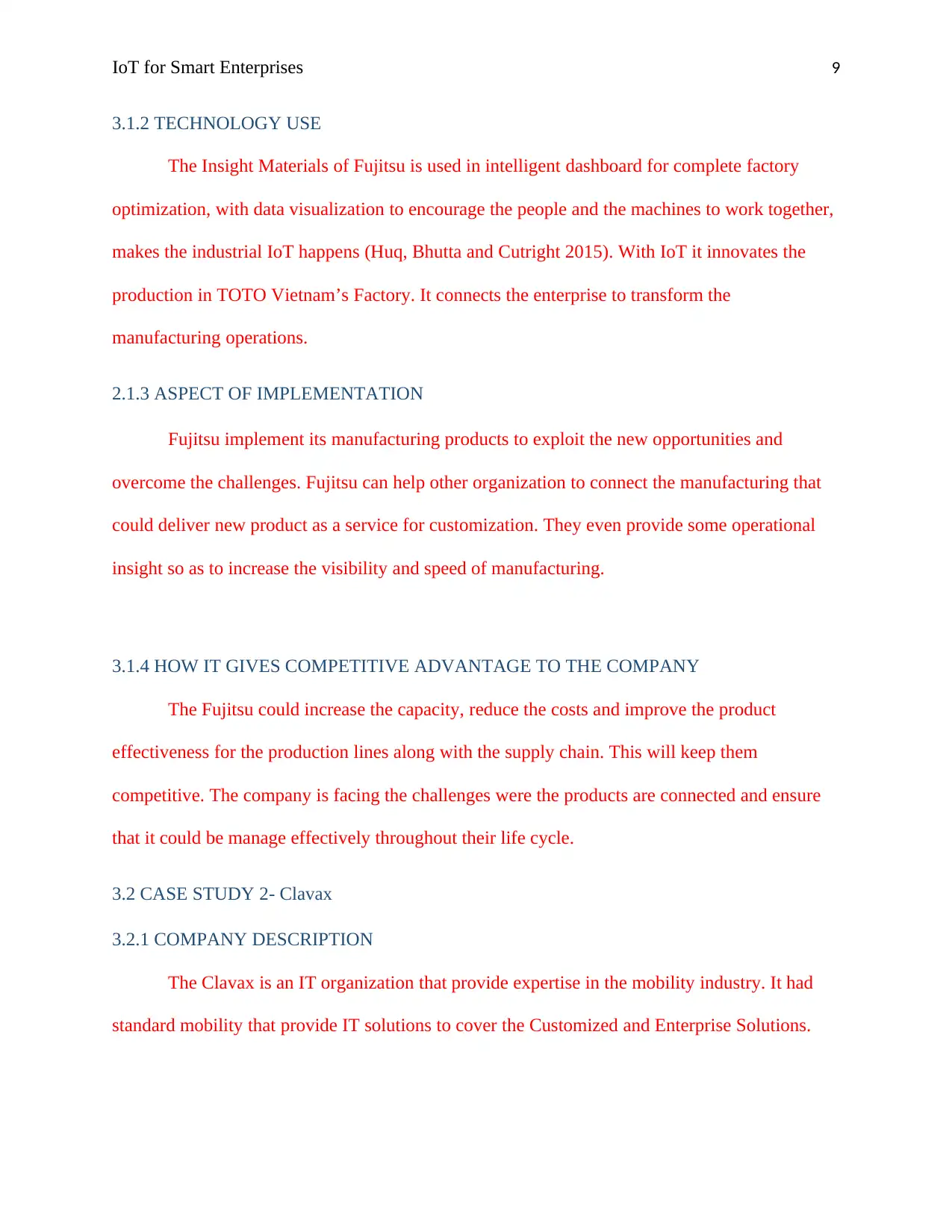
IoT for Smart Enterprises 9
3.1.2 TECHNOLOGY USE
The Insight Materials of Fujitsu is used in intelligent dashboard for complete factory
optimization, with data visualization to encourage the people and the machines to work together,
makes the industrial IoT happens (Huq, Bhutta and Cutright 2015). With IoT it innovates the
production in TOTO Vietnam’s Factory. It connects the enterprise to transform the
manufacturing operations.
2.1.3 ASPECT OF IMPLEMENTATION
Fujitsu implement its manufacturing products to exploit the new opportunities and
overcome the challenges. Fujitsu can help other organization to connect the manufacturing that
could deliver new product as a service for customization. They even provide some operational
insight so as to increase the visibility and speed of manufacturing.
3.1.4 HOW IT GIVES COMPETITIVE ADVANTAGE TO THE COMPANY
The Fujitsu could increase the capacity, reduce the costs and improve the product
effectiveness for the production lines along with the supply chain. This will keep them
competitive. The company is facing the challenges were the products are connected and ensure
that it could be manage effectively throughout their life cycle.
3.2 CASE STUDY 2- Clavax
3.2.1 COMPANY DESCRIPTION
The Clavax is an IT organization that provide expertise in the mobility industry. It had
standard mobility that provide IT solutions to cover the Customized and Enterprise Solutions.
3.1.2 TECHNOLOGY USE
The Insight Materials of Fujitsu is used in intelligent dashboard for complete factory
optimization, with data visualization to encourage the people and the machines to work together,
makes the industrial IoT happens (Huq, Bhutta and Cutright 2015). With IoT it innovates the
production in TOTO Vietnam’s Factory. It connects the enterprise to transform the
manufacturing operations.
2.1.3 ASPECT OF IMPLEMENTATION
Fujitsu implement its manufacturing products to exploit the new opportunities and
overcome the challenges. Fujitsu can help other organization to connect the manufacturing that
could deliver new product as a service for customization. They even provide some operational
insight so as to increase the visibility and speed of manufacturing.
3.1.4 HOW IT GIVES COMPETITIVE ADVANTAGE TO THE COMPANY
The Fujitsu could increase the capacity, reduce the costs and improve the product
effectiveness for the production lines along with the supply chain. This will keep them
competitive. The company is facing the challenges were the products are connected and ensure
that it could be manage effectively throughout their life cycle.
3.2 CASE STUDY 2- Clavax
3.2.1 COMPANY DESCRIPTION
The Clavax is an IT organization that provide expertise in the mobility industry. It had
standard mobility that provide IT solutions to cover the Customized and Enterprise Solutions.
⊘ This is a preview!⊘
Do you want full access?
Subscribe today to unlock all pages.

Trusted by 1+ million students worldwide
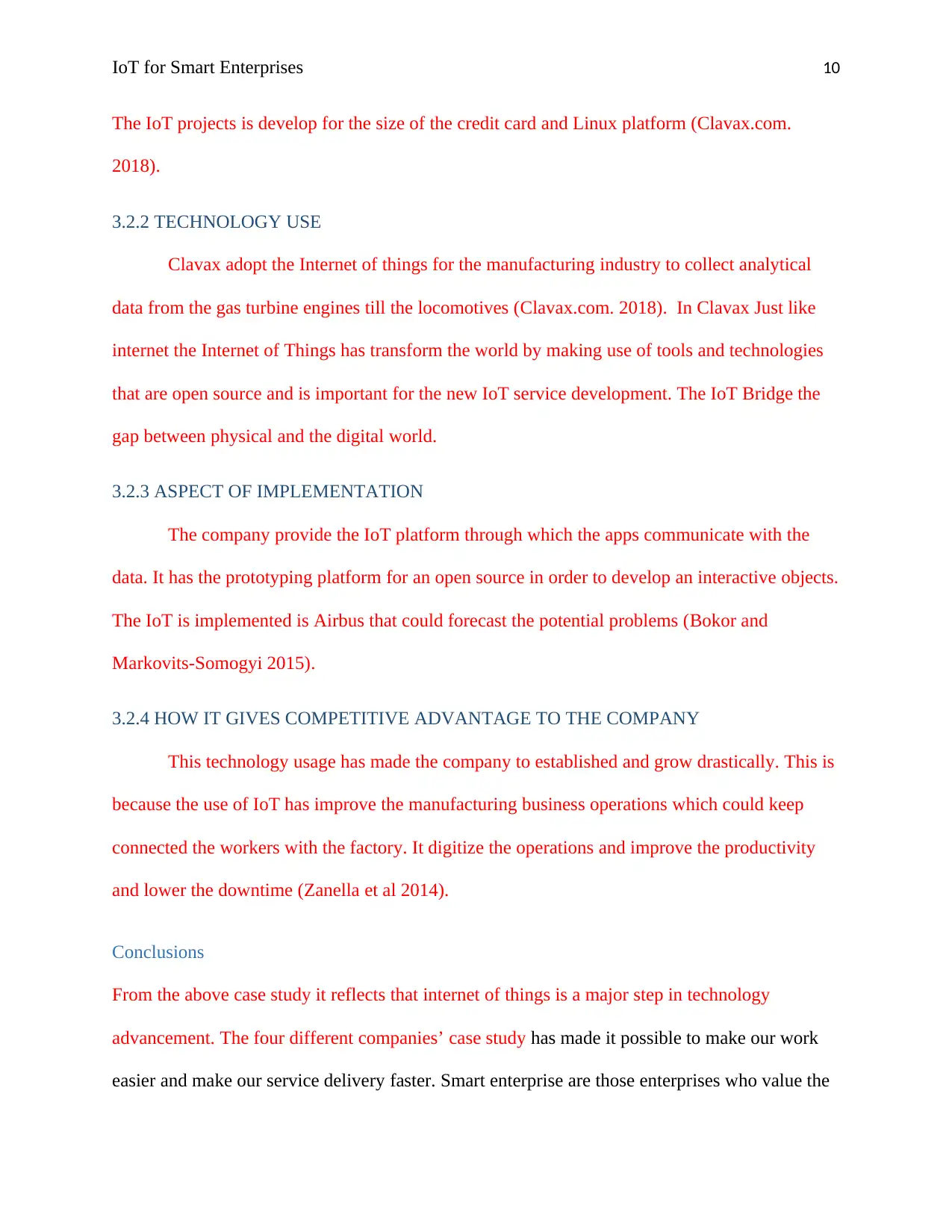
IoT for Smart Enterprises 10
The IoT projects is develop for the size of the credit card and Linux platform (Clavax.com.
2018).
3.2.2 TECHNOLOGY USE
Clavax adopt the Internet of things for the manufacturing industry to collect analytical
data from the gas turbine engines till the locomotives (Clavax.com. 2018). In Clavax Just like
internet the Internet of Things has transform the world by making use of tools and technologies
that are open source and is important for the new IoT service development. The IoT Bridge the
gap between physical and the digital world.
3.2.3 ASPECT OF IMPLEMENTATION
The company provide the IoT platform through which the apps communicate with the
data. It has the prototyping platform for an open source in order to develop an interactive objects.
The IoT is implemented is Airbus that could forecast the potential problems (Bokor and
Markovits-Somogyi 2015).
3.2.4 HOW IT GIVES COMPETITIVE ADVANTAGE TO THE COMPANY
This technology usage has made the company to established and grow drastically. This is
because the use of IoT has improve the manufacturing business operations which could keep
connected the workers with the factory. It digitize the operations and improve the productivity
and lower the downtime (Zanella et al 2014).
Conclusions
From the above case study it reflects that internet of things is a major step in technology
advancement. The four different companies’ case study has made it possible to make our work
easier and make our service delivery faster. Smart enterprise are those enterprises who value the
The IoT projects is develop for the size of the credit card and Linux platform (Clavax.com.
2018).
3.2.2 TECHNOLOGY USE
Clavax adopt the Internet of things for the manufacturing industry to collect analytical
data from the gas turbine engines till the locomotives (Clavax.com. 2018). In Clavax Just like
internet the Internet of Things has transform the world by making use of tools and technologies
that are open source and is important for the new IoT service development. The IoT Bridge the
gap between physical and the digital world.
3.2.3 ASPECT OF IMPLEMENTATION
The company provide the IoT platform through which the apps communicate with the
data. It has the prototyping platform for an open source in order to develop an interactive objects.
The IoT is implemented is Airbus that could forecast the potential problems (Bokor and
Markovits-Somogyi 2015).
3.2.4 HOW IT GIVES COMPETITIVE ADVANTAGE TO THE COMPANY
This technology usage has made the company to established and grow drastically. This is
because the use of IoT has improve the manufacturing business operations which could keep
connected the workers with the factory. It digitize the operations and improve the productivity
and lower the downtime (Zanella et al 2014).
Conclusions
From the above case study it reflects that internet of things is a major step in technology
advancement. The four different companies’ case study has made it possible to make our work
easier and make our service delivery faster. Smart enterprise are those enterprises who value the
Paraphrase This Document
Need a fresh take? Get an instant paraphrase of this document with our AI Paraphraser

IoT for Smart Enterprises 11
technology as their key player in their productivity. Internet of things enable many of the smart
enterprises across the globe to store their large amount of data in the cloud at a cheaper price.
However, despite all the discussed benefits of the internet of things security is still a threat.
technology as their key player in their productivity. Internet of things enable many of the smart
enterprises across the globe to store their large amount of data in the cloud at a cheaper price.
However, despite all the discussed benefits of the internet of things security is still a threat.
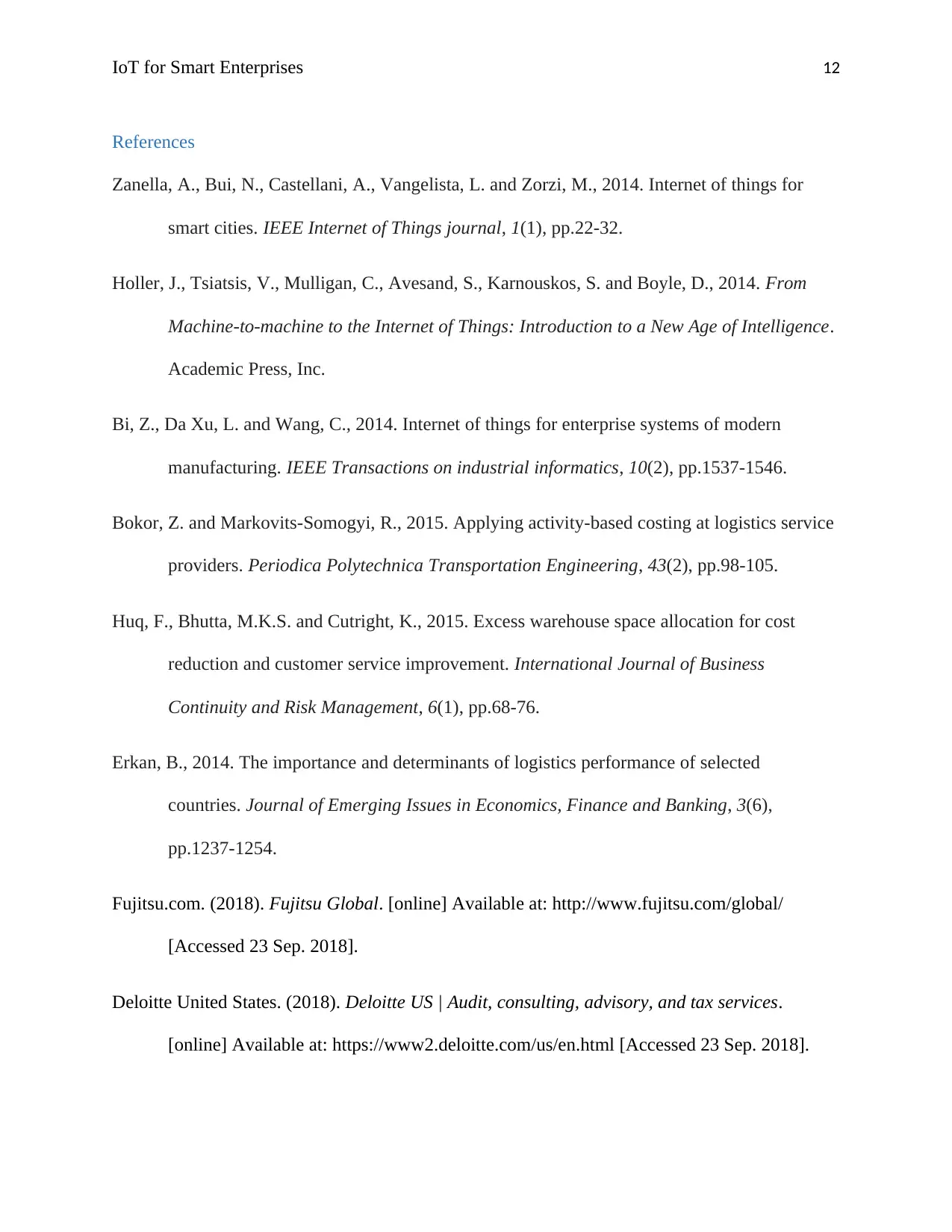
IoT for Smart Enterprises 12
References
Zanella, A., Bui, N., Castellani, A., Vangelista, L. and Zorzi, M., 2014. Internet of things for
smart cities. IEEE Internet of Things journal, 1(1), pp.22-32.
Holler, J., Tsiatsis, V., Mulligan, C., Avesand, S., Karnouskos, S. and Boyle, D., 2014. From
Machine-to-machine to the Internet of Things: Introduction to a New Age of Intelligence.
Academic Press, Inc.
Bi, Z., Da Xu, L. and Wang, C., 2014. Internet of things for enterprise systems of modern
manufacturing. IEEE Transactions on industrial informatics, 10(2), pp.1537-1546.
Bokor, Z. and Markovits-Somogyi, R., 2015. Applying activity-based costing at logistics service
providers. Periodica Polytechnica Transportation Engineering, 43(2), pp.98-105.
Huq, F., Bhutta, M.K.S. and Cutright, K., 2015. Excess warehouse space allocation for cost
reduction and customer service improvement. International Journal of Business
Continuity and Risk Management, 6(1), pp.68-76.
Erkan, B., 2014. The importance and determinants of logistics performance of selected
countries. Journal of Emerging Issues in Economics, Finance and Banking, 3(6),
pp.1237-1254.
Fujitsu.com. (2018). Fujitsu Global. [online] Available at: http://www.fujitsu.com/global/
[Accessed 23 Sep. 2018].
Deloitte United States. (2018). Deloitte US | Audit, consulting, advisory, and tax services.
[online] Available at: https://www2.deloitte.com/us/en.html [Accessed 23 Sep. 2018].
References
Zanella, A., Bui, N., Castellani, A., Vangelista, L. and Zorzi, M., 2014. Internet of things for
smart cities. IEEE Internet of Things journal, 1(1), pp.22-32.
Holler, J., Tsiatsis, V., Mulligan, C., Avesand, S., Karnouskos, S. and Boyle, D., 2014. From
Machine-to-machine to the Internet of Things: Introduction to a New Age of Intelligence.
Academic Press, Inc.
Bi, Z., Da Xu, L. and Wang, C., 2014. Internet of things for enterprise systems of modern
manufacturing. IEEE Transactions on industrial informatics, 10(2), pp.1537-1546.
Bokor, Z. and Markovits-Somogyi, R., 2015. Applying activity-based costing at logistics service
providers. Periodica Polytechnica Transportation Engineering, 43(2), pp.98-105.
Huq, F., Bhutta, M.K.S. and Cutright, K., 2015. Excess warehouse space allocation for cost
reduction and customer service improvement. International Journal of Business
Continuity and Risk Management, 6(1), pp.68-76.
Erkan, B., 2014. The importance and determinants of logistics performance of selected
countries. Journal of Emerging Issues in Economics, Finance and Banking, 3(6),
pp.1237-1254.
Fujitsu.com. (2018). Fujitsu Global. [online] Available at: http://www.fujitsu.com/global/
[Accessed 23 Sep. 2018].
Deloitte United States. (2018). Deloitte US | Audit, consulting, advisory, and tax services.
[online] Available at: https://www2.deloitte.com/us/en.html [Accessed 23 Sep. 2018].
⊘ This is a preview!⊘
Do you want full access?
Subscribe today to unlock all pages.

Trusted by 1+ million students worldwide
1 out of 13
Related Documents
Your All-in-One AI-Powered Toolkit for Academic Success.
+13062052269
info@desklib.com
Available 24*7 on WhatsApp / Email
![[object Object]](/_next/static/media/star-bottom.7253800d.svg)
Unlock your academic potential
Copyright © 2020–2025 A2Z Services. All Rights Reserved. Developed and managed by ZUCOL.





